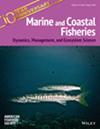Data-limited fishery assessment methods shed light on the exploitation history and population dynamics of Endangered Species Act-listed Yelloweye Rockfish in Puget Sound, Washington
Abstract
Objective
The distinct population segment (DPS) of Yelloweye Rockfish Sebastes ruberrimus inhabiting the Puget Sound/Georgia Basin was listed under the Endangered Species Act (ESA) in 2010, and a formal recovery plan for the DPS was published by National Oceanic and Atmospheric Administration Fisheries in 2017. In this recovery plan, the biological criteria for delisting or downlisting were specified as certain levels of spawning potential ratio (SPR), a commonly used metric of equilibrium stock status for commercially exploited fishes. Although this metric can be estimated from length compositions, the combination of length data with a catch history (which was not previously available for this DPS) improves our understanding of population dynamics over time and allows us to estimate a different measure of stock status, relative (to unfished) spawning stock biomass (SSB), rather than only SPR.
Methods
To estimate relative SSB and reconstruct the historical dynamics of this DPS, we reconstructed the catch history from fisheries records, collated length data from historical and contemporary hook-and-line surveys, and fitted a data-limited version of a statistical catch-at-age model.
Result
Despite a high level of uncertainty, we estimated that Yelloweye Rockfish in Puget Sound are above 25% of unfished biomass (a reference point detailed in the recovery criteria) under the assumption of deterministic recruitment, presenting the first direct estimates of Yelloweye Rockfish population status in Puget Sound.
Conclusion
However, as informed by recent genetic studies, the DPS boundaries of ESA-listed Yelloweye Rockfish extend from South Puget Sound to Queen Charlotte Strait in British Columbia. The Canadian portion of this population is managed separately and is currently estimated to be at 32% of unfished biomass (95% quantiles = 15%–68%). Thus, the disjunction between the biological boundaries of the population and the jurisdictional boundaries between Canada and the United States presents an additional source of uncertainty in assessing recovery that must be addressed to achieve DPS-wide recovery goals.


 求助内容:
求助内容: 应助结果提醒方式:
应助结果提醒方式:


